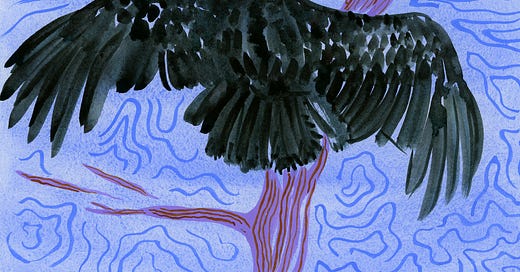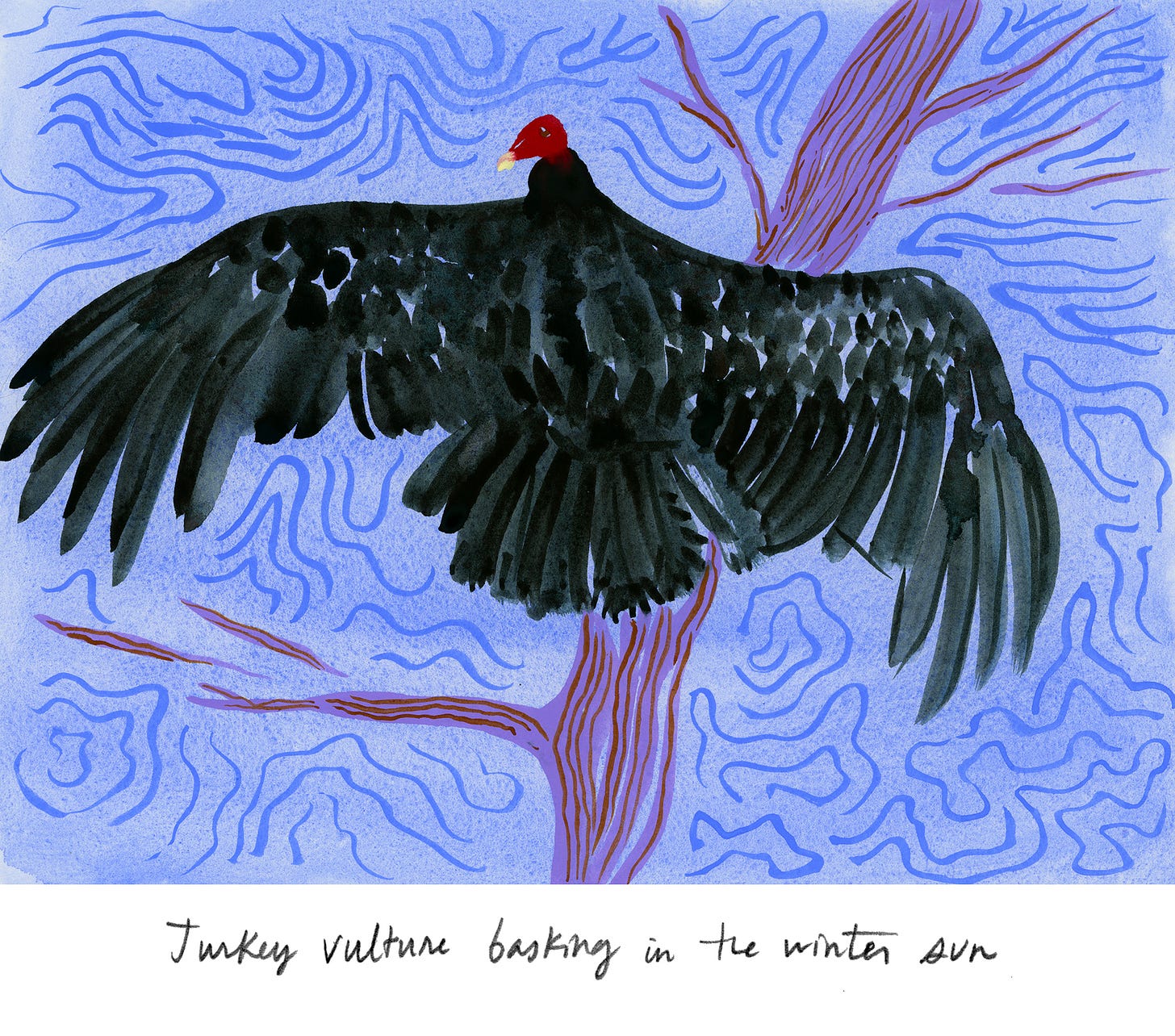Hi, friends — I didn’t intend to begin the year with turkey vultures, and yet here we are. I see them daily, patrolling the skies, unfolding their big wings and casting shadows. The vulture consumes all—and yet, it doesn’t. Turkey vultures, like all scavengers, make their existence at the end of life cycles. They turn over decay. I’ve seen them be majestic, too, making circles around a daytime moon (video below). Life is unexpected that way. As always, you can reply to this email or in the comments; I’d love to hear your stories. — Amy Jean
Maybe you’ve seen a turkey vulture (aka buzzard, aka Cathartes aura) and skipped a breath thinking it was an eagle or owl, worthy of awe—but then, no, oh well, it’s only a turkey vulture. They are scavengers, searching out stench and decay, and we dismiss them for it. Their red featherless heads are strange and disturbing. Their flight is wobbly; their feet are weak. But why do we prefer the hunter-killers over the cleaner-uppers?
Turkey vultures are enormous, with wingspans up to six feet. They are impossible to miss in pale winter skies, making their way low over the trees. I’ve been in their shadow as it swoops along the ground, and it is surprising and not a little hair-raising. Turkey vultures teeter in the air, like a biplane in an old movie, as if their engines are sputtering. They are actually efficient gliders who catch warm thermals that lift them effortlessly to higher elevations. They only wobble and correct closer to the treetops, where the air is more variable and pocketed.
Unlike the vast majority of birds, turkey vultures have a keen sense of smell. They can catch a whiff of rotting flesh from 1,000 feet in the air, from miles and miles away. It is a neat bit of puzzle-piecing, as they can find whatever the hunter-killers have left behind (all that roadkill, too), even if it’s hidden.
Turkey vultures have some funky adaptations in order to be able to eat day-old, but not many-days-old, meat. Their creepy red heads are featherless so that bacteria can’t find a safe harbor. Their nose-holes (more technically nostrils or nares) don’t have a septum, so you can see straight through their beaks; this keeps fleshy bits from sliding down somewhere unreachable. Their stomachs are fierce and full of super acidic juices. Fun fact: turkey vultures are rarely threatened, but if they are they will projectile vomit some of their smelly stomach juices (they can aim, too).
Turkey vultures are one of the more common big birds around Connecticut, and one of the more common across North and South America. They can live up to 15 years in the wild (to their 30s in captivity). Beyond simply cleaning up dead animals, they actually process the pathogens in them, ridding the environment of salmonella, rabies, bubonic plague, anthrax (seriously—anthrax! plague!—these are obliterated in their miraculous guts).
I also like this tidbit, that other vultures and condors will follow turkey vultures, knowing that their sense of smell is much better than theirs. Not un-relatedly, human engineers use turkey vultures to detect leaks by pumping a gas that smells like carrion into natural gas lines. If turkey vultures arrive on site, they know there’s a leak.
Circling vultures are called a “kettle” because they look like bubbles rising in boiling water. I’ve always appreciated the soaring abilities of turkey vultures when I see them around town. Their grace is a surprise. Without a doubt, they are under-appreciated and not as well studied, either. And yet, turkey vultures are essential and of enormous benefit to us and to entire ecosystems. Maybe they are a little strange or ugly, but they are absolutely majestic, too.
Turkey vultures circling a daytime moon, Connecticut, March 4, 2020.
Turkey vulture links—
Someday I’d like to be the person holding the bird, but till then I appreciate the amusing array of videos featuring turkey vultures with big brown eyes and names like Gwendolyn. To me, they have the appearance of little old ladies with elaborate feather ruffs. Vinnie, meanwhile, makes an appearance at the Cleveland Museum of Natural History.
There are some pretty sweet moments of a wild turkey vulture pair raising two chicks in the hollow of a sugar maple tree in this 9-min. vid [YouTube]
“There’s even an entire class of bacteria that we’ve discovered on vulture plumage that’s unknown to science. It does not have a name.”—Gary Graves, from “Meet the Scientist Studying Vulture Guts for Clues to Disease Immunity” [Smithsonian]
Animal encounters in recent comments—
Also—
The January issue of Wild Life / Rabbit, Rabbit featured an arctic hare hopping like a kangaroo on its back legs. Subscribe or give a gift below for good luck, and to learn more about rabbits.
Wild Life #37 / this newsletter is a place to learn about the life around us, one kettle of vultures at a time. I do this because I’m not sure what to do about the millions of species in danger of extinction. It means something to see and enjoy the life around us. Thanks for reading and see you in a couple of weeks.






That parks video about the two young turkey vultures is amazing! We've been watching a bunch of Animalogic videos (on YouTube), and the one about the Marabou Stork covers another fascinating carrion bird. https://www.youtube.com/watch?v=6J5r7xEsCik&list=PLLp_Uzlh36zUSp6dI3aSJwZEAM4jIJAXo&index=1
I loved this. I just finished reading Bernd Heinrich's "Life Everlasting, " about nature's undetakers. You both have helped me to appreciate animals who do so much to keep the earth alive by eating the dead.